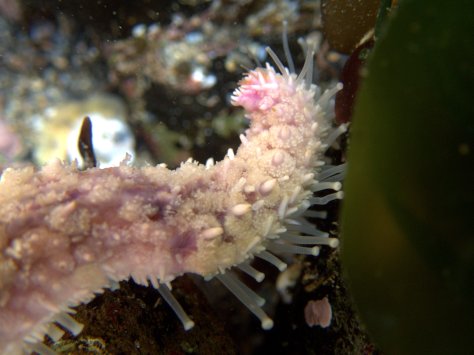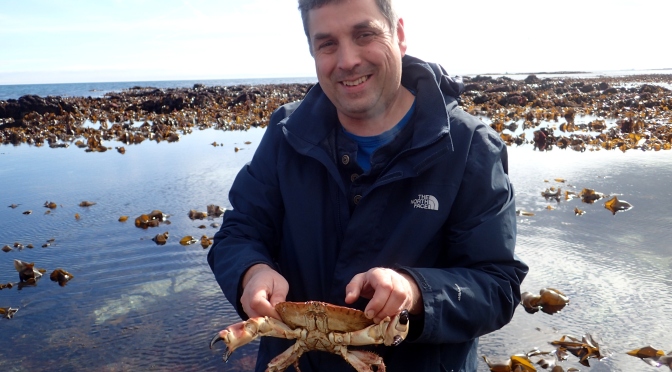It’s that time of year again. Amazing spring tides, ideal conditions and, of course, it coincides with Other Half’s birthday. Lucky him! What else could he possibly want to do but come rock pooling? To be fair, he needs no persuading that it beats a day in the office and, as a birthday treat, I offer him an evening out afterwards – watching me give a talk at the Cornwall Marine Recorders’ event in Gwithian (with a bar and nibbles).
We pile into the car ridiculously early in the morning to make sure we make it to Prisk Cove in time to meet our lovely friends and their twins to explore as the tide rolls out.
This beach is a little off the beaten track, but worth the walk. We find it empty of people and the tide so far out that the kelp hangs limply in shallow pockets of water in the bay.
The beach’s sheltered position between the Helford and Falmouth Bay, combined with the huge numbers of loose boulders, makes this habitat perfect for many marine species. Despite his initial certainty that he won’t find anything, Junior’s friend is first to find a spiny starfish. Its long tapering arms set with thick spines have an attractive purple hue.

We watch its many tentacle feet reaching out to explore the rocks.

The asymmetric heads of flat fish always intrigue me, so I am delighted when we find the first little topknot, then more and more of them. Some are sticking to the rocks, even clinging on when completely upside down, using their fringing fins to mould themselves to bumps and imperfections in the surface. Their mottled patterns can make them hard to spot and they stay completely still to avoid detection.


Under a large rock we find a large edible crab that makes the other twin shriek. She soon overcomes her nerves when I move it out of the way so that we can look at the fish, which are also sheltering here.
Everyone crowds round to see the stunning colours and impressive headgear of the tompot blenny, and the kids are amazed by the smoothness of the rockling’s eel-like skin.

Other Half holds the edible crab for a quick birthday photo before we pop everything back where we found it.

Out among the furthest accessible rocks, the twins’ mum is not being outdone. She brings some fish over to show me, among them a beautiful goldsinny wrasse. It’s not a fish I often see on the shore, but it is easily identified by its two dark spots, one at the front of its dorsal fin and the other at the top of its tail.

It has wide orange eyes with a flash of blue and the wonderful pouting lips of the wrasse family.

The finds flood in and I struggle to keep up with taking photos of everything to ensure that I can submit records afterwards. On one area of the shore I find a large patch of Wakame.
This invasive non-native seaweed is easily identified by its corrugated-looking stipe and thin, floppy fronds. Originating from China, Japan and Korea, it has spread widely in Europe and can out-compete native seaweeds.
White painted top shells, an improbably hairy purse sponge and an interesting anemone all catch my eye before the tide turns.


I also discover half a dozen shark eggcases of the Greater spotted catshark (Scyliorhinus stellaris) attached to the rainbow wrack of the lower shore pools.


All too soon it seems, the tide is flowing in. At first it is a faint current, but it turns quickly into a churning river through the tight gullies and we retreat to enjoy a birthday picnic.







Do you remove the Wakame whenever you find it?
LikeLike
I didn’t this time as the tide was turning. Seaweeds can be very hard to control. I’ll put the photos in to Natural England as they were trying to control it – though they may have given up by now? Maybe someone will eat it?
LikeLike
What a perfect way to celebrate a birthday! Beautiful pictures of interesting ‘finds’. I’ll add Prisk Cove to my list….
LikeLike